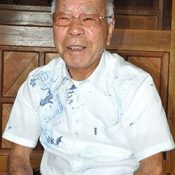
November 19, 2019 Ryukyu Shimpo
Ryota Nakamura
During U.S. rule of Okinawa in 1958, there were many Uchinanchu who went to Thursday Island in northern Australia with dreams of getting rich pearl diving.
Senshu Arakawa, 86, from Kenken, Motobu was one of them. The reality of a job at sea is a harsh one that sits side by side with death, and some of the divers that crossed the water with him from Motobu perished from things like decompression sickness.
Even so, Arakawa, for whom the memories of over half a century ago are starting to fade, dreams of visiting again, saying, “I would like to go as long as I am healthy.” It is common knowledge that high quality pearls can be harvested in the northern regions of Australia, which include islands like Thursday Island, and many Japanese divers flocked to the area in the 1950’s and 60’s.
At first, most of the divers came from Wakayama and were equipped with advanced diving technology for the time, however they were all recalled to Japan after World War II. Selected as replacements were the Uchinanchu living under U.S. rule.
Okinawa is surrounded by water and filled with fisherman. For Uchinanchu, pearl diving was an attractive job that was rumored to lead to riches.
Arakawa was at the time engaged in recovering fighter aircraft from the ocean, and applied to become a pearl diver when he saw they were hiring. In March of 1958, Arakawa set off across the ocean with his father Sentatsu and 150 people from his village.

“Uchinanchu in Australia,” which shows the pearl divers visiting from Okinawa
Arakawa had a contract with the pearling company Whyalla Shell, and worked at gathering shells in teams of six people on three boats.
Arakawa dove into the ocean wearing a diving mask that looked like a spacesuit, while his father Sentatsu oversaw the operations as an engineer.
“The pearls were clumped together in the sand.” Often he was able to fill his basket with a single two-handed scoop. When that would happen, they would raise the big catch flag on the mast of their pearling boat and return to port.
Arakawa reflected on his experiences, boasting, “The shellfish were tasty. The pearls were fantastic, they had a shine to them that farm-raised pearls do not.” However, pearl diving in the area around Thursday Island had already peaked. “They had already been picked out,” says Arakawa, noting that the volume of pearls steadily decreased. Even though he had a three year contract, he returned to Okinawa after only a year.
(English translation by T&CT and Sam Grieb)
Go To Japanese
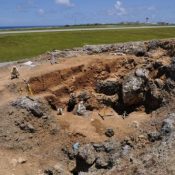
November 15, 2019 Ryukyu Shimpo Digital Edition
On November 15, the national government’s Council for Cultural Affairs issued a report to Education Minister Koichi Hagiuda indicating that the Shiraho-Saonetabaru Cave Ruins, located in Ishigaki City, is to be newly designated as a National Historic Site.
The oldest human remains to be discovered in Japan, around 27 thousand years old, have been found there, and the site was lauded for its high academic value. The official designation will be made soon by announcement by official gazette.
A large number of well-preserved human remains have been found at the cave site.
The discovery there of tombs and gravesites housing Pleistocene human remains from the Paleolithic era was the first such discovery in Japan.
The Council for Cultural Affairs stated that the site enables confirmation of a long history of funeral practices using limestone caves and spaces in the shade of rocks, and said that the site “has epochal significance leading to critical insights in physical anthropology.”
“I am very happy. The Shiraho-Saonetabaru Cave Ruins are indispensable for an accurate historical understanding of this country, and the site is academically valuable in terms of its scale and the remains and unearthed relics there,” said prefectural superintendent of education Shojin Heshiki regarding the Council’s report.
The cave is inside the Ishigaki Airport grounds, and the site is being preserved.
The Council also reported that one Special Historical Site and 18 Historic Sites/Places of Scenic Beauty/Natural Monuments are to be newly designated, as well as 29 additional designations etc. and five new registrations of Registered Monuments.
(English translation by T&CT and Sandi Aritza)
Go To Japanese

November 8, 2019 Ryukyu Shimpo
Cocco, who celebrated the 20th anniversary of her debut in 2017, released her 10th studio album, StarShank, in October (3,000 yen before tax, Victor Entertainment).
Released three years after the release of her previous album, Adan Ballet, Cocco once again teamed up with producer Takamune Negishi, who has worked with her on the creation of countless songs since her debut.
She will soon set out on a nationwide six-stop tour, starting in Miyagi prefecture December 6. We recently caught up with the singer (interview by Kengo Fujimura).
– What have you been up to since your last album?
“I’ve been keeping to myself, doing things like writing songs for other artists. When I am out walking with my 20-year-old son, we are mistaken for a couple, and I’ve had people try to scout me as a model.
The person who approached me was young, and might not know Cocco, and it made me think, “Maybe I’ve been reborn.”
– Can you write songs even while staying secluded?
“I can. For me, [writing songs] is like a physiological phenomenon, like when you have to go to the bathroom after waking up, so I don’t think about it too much.
I write songs every day. So, when a request comes in for me to write a song, my reaction is, ‘Well, I have today’s song.’”
– Tell us about the thoughts that went into the song “2・24,” which refers to February 24 (2/24), the day of the referendum vote in Okinawa asking if the citizens of Okinawa either approved to disapproved of the land reclamation work in Henoko for the new military base facilities.
“I think ‘2・24’ came from an idea just before the referendum vote, that we should defend ourselves as best we can, build a shield for our own defense.
In the end, even though the people of Okinawa said ‘No’ (to the new base facilities in Henoko), the government overruled that answer with a ‘Yes.’ In my 40 years, there are a lot of things I have given up on.
When it happens, there is a great sense of loss, pain, and crying. But, these children, who at around the same age as my son just earned the right to vote, earnestly believed that ‘the No might win.’
When they see what eventually happened, I think it came as a great shock to these young people, and they cried. We can’t seem to stop this situation that leads to young tears.”
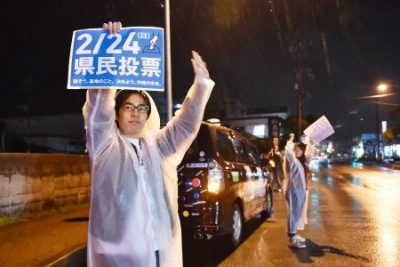
Young activists standing in the rain calling for people to participate in the referendum vote on U.S. bases in Okinawa. February 24, 2019, Naha
– The land reclamation work started the day after the referendum vote.
“Even though there was strong opposition, I feel that what happened was to be expected. Since the government won’t change, we have to broaden our tolerance level. If continues to be obstinate and further harden their shells [it will never end].
Even if there is news about Henoko, I can’t watch. ‘It’s OK, we knew this would happen it’s ok,’ I say to protect myself, it is the best I can do.”
– You have been making efforts to support young artists, such as using young directors for your music videos.
“Now that I am older, there is no motivation left for me to sing for my own sake. I was 19 when I made my indie debut.
My own child is older than I was then. When I was 19, 20, countless adults helped me out, entrusting the baton to a girl from Okinawa who came to Tokyo, knowing nothing. Now that 22 years has passed I think I need to pass that baton down to the next person.
The landscape that was shown to me that allowed me to make music was fantastic, and I want to show it to the next person.”
– Who do you sing for now?
“When I was 19, I thought that I could change the world, and I believed that I could tell everyone no.
It would have been difficult to be recognized as the ‘real deal’ without the help of those who came before me.
So, my driving force is the idea of handing the baton off to the next generation, so that they can become ‘the real deal.’ However, I think the reason I can still sing is because I am singing for Okinawa.
I learned that because I am singing for someone, it is helping me keep going.”
– It is said that “People give up once they pass 40.” Isn’t that something that should be disparaging to young people?
“If young people don’t have hope, I don’t think we can hand the baton to them.
My skin has already accumulated enough scars and become thick [metaphorically speaking], but young people are still have skin that is soft and unscarred, and I worry about what lies ahead for them.
I want to support them as much as I can [with regards to the Henoko base construction issue].
If they are saying ‘No,’ then I will say ‘Certainly no, I am here to support you.’ If a sacrifice is needed, I am here for it.
Because otherwise it will be a repeat of when I was young and unscarred. I want to support them, and I want to protect them.”
(English translation by T&CT and Sam Grieb)
Go To Japanese
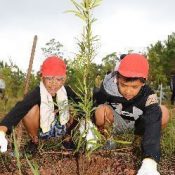
November 15, 2019 Ryukyu Shimpo
On November 14 a council for cultivating trees for use in the restoration of wooden buildings starting with Shuri Castle, the Tree-Cultivating Council for Shuri Castle (chaired by Kanko Teruya), tended to yew plum pine and fukugi trees in the national forest in Taira, Higashi Village.
Higashi Village 4th-year elementary school pupils also came to try their hands at fertilizing and planting saplings.
Since the Council’s establishment in 2008, it has planted and managed the cultivation of about 1,800 trees such as yew plum pines and Quercus miyagii in national parks in Ada, Kunigami Village and Taira, Higashi Village.
Under the guidance of Council staff such as the Okinawa district forest office, pupils skillfully fertilize and trim the saplings.
Ayuto Kinjo, 10, said, “Since we had planned to go to Shuri Castle on a field trip, I was sad to hear about this fire.
I hope the trees here are useful in the future”. Eito Awa, 10, said, “It was my first time planting trees, it was fun. I hope the trees grow big, soon”.
As concerns the Shuri Castle fire, Chairman Teruya said, “At this point in time the necessary wood supply for reconstruction is not enough. I hope these efforts continue for 100 or 200 years to come”.
(English translation by T&CT and Erin Jones)
Go To Japanese

November 15, 2019 Ryukyu Shimpo
The awards ceremony for Peace in the Streets Global Film Festival 2019 was held on November 6 at the United Nations Headquarters in New York, followed by a screening of the winning films.
The film festival is organized by the Peacemaker Corps Association (PCA), a non-profit organization.
Kosei Matsuyama, 11, a sixth-grader at Okinawa Amicus International Elementary School, placed third in the “Age Group 9-13” division.
Matsuyama submitted a five-minute film on the Fukushima Nuclear Accident titled, Nuclear Power Plant in Fukushima as Seen by Okinawa Student.
Matsuyama visited Fukushima Prefecture and interviewed Toshihiko Watanabe, a private attorney who assisted voluntary evacuees win compensation, and Dr. Ryoji Aritsuka, a psychiatrist who has researched PTSD in the victims of Fukushima.
The sixth-grader tells the current state of Fukushima through interviews, and questions the necessity of nuclear power.
The film raises issues of nuclear waste management and the harmful effects a nuclear accident has on the human body and mind.
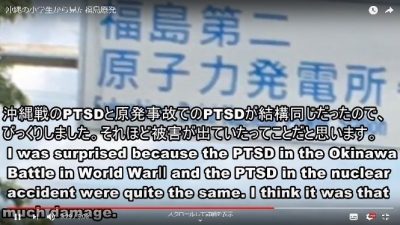
A frame from Matsuyama’s short film, Nuclear Power Plant in Fukushima as Seen by Okinawa Student, which placed in the peace film festival.
Matsuyama also offered his own view that, “we should consider alternative energy sources.”
The young creator explained his motivation for this film, “I wanted to share what is happening in Fukushima today and what is on the minds of the local people.”
Matsuyama gave his speech in English at the awards ceremony, and engaged in discussions with the audience.
He is currently working out the concept for his next project, which will explore the relationship between the Japanese Constitution and the construction of the new Henoko base in Nago City (a move involved in the relocation of Marine Corps Air Station Futenma.)
Matsuyama said stylistically, he wants to try his hand at “a docudrama, incorporating easy-to-follow dramatizations in addition to interviews.”
The young film maker’s artistic growth is promising.
(English translation by T&CT and Monica Shingaki)
Go To Japanese
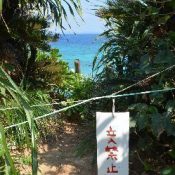
Yo Kakazu
(Nanjo) Kudakajima Island, part of Nanjo City, is known as a sacred place in Okinawa, and roughly 60 thousand people visit there each year.
Many tourists have been trespassing in off-limits sacred spots (utaki) and waters, and islanders who have worked to protect the ancient history and traditions of the island are vexed.
There are many photographs taken in off-limits areas posted to SNS sites and elsewhere on the internet, as well as posts that could cause the erroneous impression that there are private beaches on the island.
Islanders who work as tour guides on the island say they wish visitors would come and post about their experience with a true understanding of the island’s characteristics and culture.
All of Kudakajima Island is considered a sacred area, and some utaki and coastal areas are off-limits.
A sign reading “This is an utmost sacred place. Not a single person may enter” is posted at the entrance to Fubo Utaki, where ceremonies such as Izaiho are held.
However, tourists continue trespassing, and Kota Nishime, 36, leader of the Kudakajima Youth Organization, says angrily, “I have warned several people who I saw coming out of the utaki.
They don’t understand enough just how much we islanders treasure this spot.”
Fubo Utaki is not the only place where trespassing is an issue.
Megi Beach, near the port, is the only place on the island where swimming is allowed, but many photographs of people swimming in waters other than those at Megi Beach have been posted to Instagram.
Some posts even describe false rules to the effect that access to the beaches is allowed to those who meet certain conditions.
There are also many comments that these are “private beaches,” which troubles Tadashi Nishime, 60, head of Kudaka Ward.
“There’s nothing like that here. But people keep seeing those posts and coming here,” said Nishime. A few years ago, a “no trespassing” sign and fence were put up at Udi Beach, but tourists keep visiting there.
Instagram posts are not the only problem.
Many tours are being planned on Facebook and other internet sites with the aim of profiting off the power of Kudakajima’s sacred spots.
“Usually none of the guides are even from the island,” says Kota Nishime.
“They could be spreading inaccurate information about the island’s history and characteristics. I’m very concerned.”
(English translation by T&CT and Sandi Aritza)
Go To Japanese
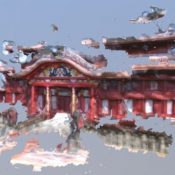
November 12, 2019 Ryukyu Shimpo
Image processing and virtual reality experts are teaming up to form the “OUR Shurijo – Shuri Castle Digital Reconstruction” project, which aims to create a digital reconstruction of the recently burned down Shuri Castle.
The project will collect pictures and videos of the castle from different viewpoints, and create a digital 3D model of the castle using digital modeling technology.
The members of the project are asking for submissions from all over the world. University of Tokyo project lecturer Dr. Rei Kawakami, who is at the center of this project, said, “After completion, we will make it available for the people of Okinawa to use as a digital tourist attraction until the real castle is rebuilt.”
The more pictures and videos they collect, the more detailed the digital model can be, so the project is aiming to collect around 1 million submissions.
According to Dr. Kawakami, a homepage for the website went up November 5, as well as a twitter handle that was started to solicit contributions.
Already pictures of the castle are pouring in from all over the world, and as of November 8 they had already collected 10,000 contributions.
Researchers from abroad are also participating in the initiative, and submissions are coming in not just from Japan, but also the U.S., Europe, and Africa.
Dr. Kawakami is a computer vision expert, researching how to get a computer to understand images.
Having visited Shuri Castle, she said, “The fire was a huge shock. Hearing the news that children could not go to school because of the fire made me feel sad.”
Dr. Kawakami was in Korea for an international conference the day of the fire, October 31, but started the project as soon as she returned to Japan.
The project is not only asking for images, but also information such as when the pictures and videos were taken, and any memories from the people who were there at the time.
The aim is for these memories to pop up when people enter the 3D recreation, something Kawakami has coined “compassionate content.”
You can visit the homepage for the project here: https://www.our-shurijo.org/
(English translation by T&CT and Sam Grieb)
Go To Japanese
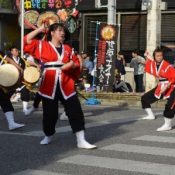
November 11, 2019 Ryukyu Shimpo
A student club of the Concord University College Fujian Normal University, the “Sanmo Eisa Club” (eisa is a traditional Okinawan dance) performed at the Mutsumi-bashi intersection on Kokusai Street in Naha City on November 10, in collaboration with various Okinawan eisa and hatagashira (flag parade performance) groups, boosting cultural exchange.
The performance was a fusion of traditional Chinese dance and eisa.
The leader of the Sanmo Eisa Club, Lin Yanjuan, 23, said, “I’m happy we got to see the traditional Okinawan eisa dance live, and I enjoyed performing.”
The event also hosted a donation drive to help restore Shuri Castle, which was destroyed in a recent fire.
The group’s subleader, Lin Guizhen, 22, flashed a smile and said, “I’m glad to help the cause.”
(English translation by T&CT and Monica Shingaki)
Go To Japanese
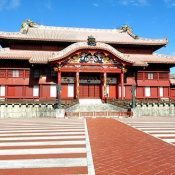
November 7, 2019 Ryukyu Shimpo
Mariko Nakamura
Nov. 7—It’s been one week since Shuri Castle’s seiden, or the main hall, was destroyed in a fire. A full investigation of the prefecture’s management will come, meanwhile, mapping out a path to reviving the castle is proving to be a challenge as well. Gov. Denny Tamaki visited Tokyo shortly after the fire and requested the Japanese government to rebuild the castle expeditiously. During the cabinet meeting on Nov. 6, Prime Minister Shinzo Abe indicated the government will assume charge of the reconstruction efforts including its funding. However, quite a significant number of Okinawans feel uneasy with a Japanese government-lead reconstruction of what is an “Okinawan symbol,” despite the Shuri Castle Park being a state-run park. Who should lead the project, the national government, or the prefecture? The public opinion in Okinawa is split. This article looks back on the history of Shuri Castle, before debates surrounding the project further intensifies.
Shuri Castle was built by Satto, the Chuzan King during the mid-14th century. The multi-storied castle was built in 1392, which is said to be the origins of the Shuri Castle’s main hall. In the following six centuries, the castle—the King’s home and workplace, burned down three times in succession wars. It was reconstructed each time.
In 1879, the Japanese government sent 600 Kumamoto-chindaihei (soldiers of ancient Japan) and policemen to Ryukyu; the men entered Shuri Castle and presented the Ryukyu king, Sho-Tai, with a letter instructing the King to abolish his rule and join Japan as a prefecture. Annexed by force (also known as the Ryukyu disposition,) Shuri Castle was surrendered to Japan and Okinawa Prefecture was established.
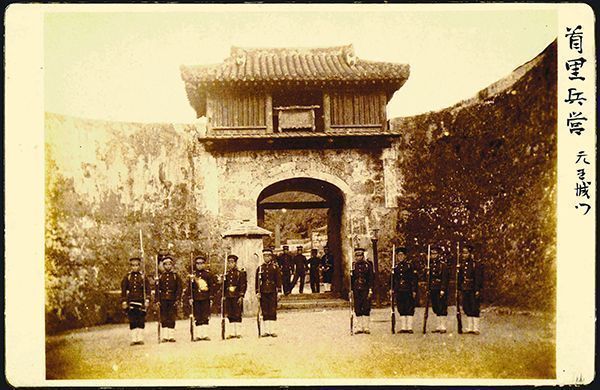
Meiji government soldiers pose for a photograph in front of the kankai-mon, the first main gate of the Shuri Castle. The soldiers, known as the Kumamoto-chindaihei, were deployed from Kumamoto Prefecture. (Courtesy of JCII Camera Museum)
In 1944, the Japanese 32nd Army set up its headquarters at Shuri Castle and dug a sizable underground network of tunnels beneath it, in preparation for the Battle of Okinawa. This made the castle a target for the U.S. military, and the castle was bombarded to ashes by naval gunfire.

A photo from Masahide Ota’s book, This was the Battle of Okinawa, shows Shuri Castle in ruins after the Battle of Okinawa.
After World War II, the U.S. Military Government of the Ryukyu Islands controlled Okinawa, and made the decision to set up a university where the castle used to stand. Shuri Castle belonged to Shuri District prior to WWII, but the former City of Shuri took over after the war. According to an account given by Seimo Nakayama in the university’s 10th-anniversary magazine, Director Atsuo Yamashiro and Division Chief Dr. Arthur E. Mead of the Civil Information and Education Division of Ryukyu Military Government visited Shuri City Mayor Yuumei Kaneshima to discuss the using the Shuri Castle site as a university campus. The land-rights were turned over after the Shuri City Council passed a resolution.
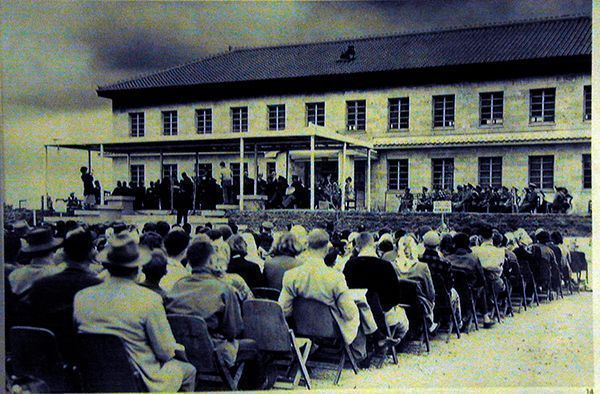
The opening ceremony of the University of the Ryukyus, built where Shuri Castle used to be.
When Okinawa was returned to Japan in 1972, the University of the Ryukyus was entrusted to the national government, becoming a national university. The Act on Special Measures Incidental to the Reversion of Okinawa clearly dictates that the rights and obligations of the university will be set forth by the National School Special Account Act.
Shinichi Isa, former Ryukyu university staff and historian of modern Okinawan history, asserts that “The 1972 ‘transfer’ of land rights from the Ryukyu government to the Japanese government is the reason behind Okinawa’s increasing dependency on Tokyo.” Isa says there is no recorded testimony that shows Okinawan uncertainty over this “transfer” of rights, and theorizes that Okinawans may have been optimistic at the time.
Objections and concerns
The Ryukyu government put together a plan to restore war-damaged cultural assets and rebuild Shuri Castle, and requested the Japanese government to execute. Tokyo’s response was lukewarm, stating it would not build two national parks in the same prefecture.
Zenki Nakazato, former vice governor who served as section chief and director of tourism department of the prefectural government, urged the Japanese government to take action. He remembers that, “A state-run park would mean it’s state-owned, so Sadanori Yamanaka used to worry, ‘What would our people say? Will they object?’ I told him, it wouldn’t matter to Okinawans if the park was state-owned or prefecture-owned, [Shuri Castle] is an important inheritance for all Japanese citizens.” In 1986, The Cabinet decided the government will work on Shuri Castle as a state-run park. Nakazato said, “We have to credit Mr. Yamanaka.”
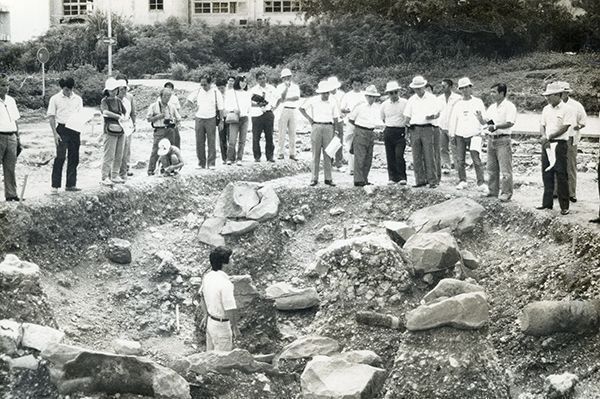
An on-site briefing of the excavation of Shuri Castle’s main hall, September 1986.
On the other hand, Okinawa had its own plans to construct a prefectural art college where the university campus used to be. However, Japan’s Ministry of Education held jurisdiction of the land, which complicated its acquisition. In the book
Yomigaetta Shurijo (Literally: Shuri Castle revived,) Shigematsu Shiroma, minister of education at the time, said, “We really tried to acquire the site for free through amending the Law on Special Measures for the Promotion of Okinawa, as well as the Cabinet Order.”
Former director of Okinawa Development Agency, Mitsunori Ueki, was an LDP subcommittee chair at the time. He supported the negotiations and said, “Originally, the former City of Shuri gifted the Shuri Castle site to the University of the Ryukyus, which was then transferred to Japan upon Okinawa’s reversion. If you understand that history, you realize the prefecture need not pay for this acquisition.”
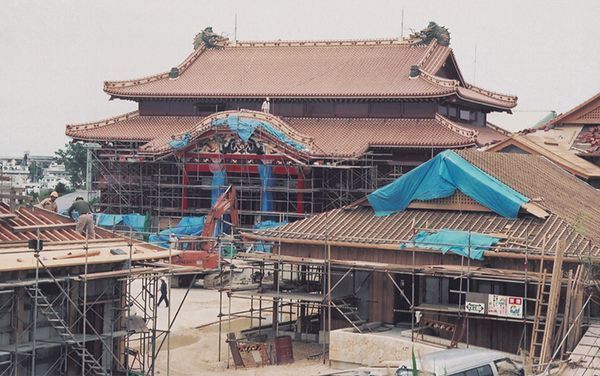
Shuri Castle under construction, March 1992.
After a push from both the public and private sectors, it was decided that the inner bailey of the Shuri Castle Park would be a state-run project, and the outer bailey would be a prefecture-run project.
But who will lead the reconstruction of the main hall lost in the fire? University of the Ryukyus Professor Emeritus Kurayoshi Takara, who previously worked on the restoration of the castle said, “We have experience with state-run projects to restore Shuri Castle. Can the prefecture rebuild the castle from scratch? We need to think about which government will be able to responsibly and expeditiously return the castle back to life.”
On the other hand, Isa points out that, “Given the long-talked-about issue of Okinawan independence, in the long-run it may be important for the prefecture to first take an independent approach, and assume the reins on a reconstruction plan.”
What roles should the prefecture and the national government play in this project? To arrive at an answer, a look at the site’s historical background and thoughtful discussions are imperative.
| Shuri Castle chronology |
| Mid-14th century |
Chuzan King, Satto, builds Shuri Castle |
| 1392 |
The first main hall of Takayo Souri-den is constructed within the Shuri Castle grounds |
| 1879 |
The Ryukyu Kingdom is annexed and dissolved. Shuri Castle is surrendered to the Japanese government |
| 1909 |
Ownership of the castle is transferred to Shuri District. The district passes a resolution to demolish the site |
| 1925 |
Shuri Castle’s main hall is designated a national treasure |
| 1928-1933 |
Major repair of the main hall |
| 1944 |
The Japanese Army sets up their headquarters at the castle, digs a tunnel network beneath it |
| 1945 |
The castle is obliterated during the Battle of Okinawa |
| 1948 |
Upon inspection, the decision to use the devastated site as the University of the Ryukyus campus is made by the U.S. Military Government of the Ryukyus |
| 1950 |
The University of the Ryukyus opens its doors |
| 1970 |
The Ryukyu government forms a restoration plan, puts it to the Japanese government |
| 1972 |
Okinawa’s reversion to Japan |
| 1982 |
Project proposal of “Shuri Castle Park” is worked into the second Okinawa development and promotion plan |
| 1984 |
Mitsunori Ueki announces his shuri-suimui concept (National Shuri Castle Park concept). The prefecture creates a master plan based on Ueki’s ideas. Ryukyu University moves to Nishihara City |
| 1986 |
Cabinet greenlights the project as the National Government Okinawa Commemorative Parks Shuri Castle Site. Okinawa prefectural decides the area surrounding the state-run park will be a prefecture-run park |
| 1989 |
The inner bailey of Shuri Castle Park is transferred from the purview of the (former) Ministry of Education to the Okinawa General Bureau.
Construction work of the main hall begins
|
| 1992 |
Partial opening of Shuri Castle Park |
| 2000 |
The hokuden, or the north hall, serves as a venue to the G8 Summit banquet.
The Shuri Castle ruins, Sonohyan-utaki and the Tamaudun masoleum are designated UNESCO World Heritage Sites
|
(English translation by T&CT and Monica Shingaki)
Go to Japanese
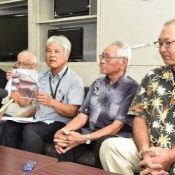
November 6, 2019 Ryukyu Shimpo
On November 5 the Prefectural Ryukyu Red Tile Plaster Craftsmanship Cooperative, which is made up of craftsmen of Okinawan traditional red roof tile, submitted a written appeal to Okinawa Governor Denny Tamaki requesting that burned red tiles from Shuri Castle be preserved and used.
After making their appeal, a member of the cooperative stated in a press conference, “The tiles that have survived the fire have material value, and will be a symbol of revival”.
The written appeal made three requests: that (1) burned red tiles be recovered and used to the extent possible, (2) reusable tiles be used in reconstruction and restoration, and (3) the cooperative be involved in recovering tiles.
According to the cooperative, the red tiles of Shuri Castle were the work of Soten Okuhara, who died in 2014.
Red tiles made by Okuhara have the characteristics of remaining solid when burned at very high temperatures and having a glossy surface.
Director Tadashi Tabata of the cooperative said: “I heard that his soil blends and the like are special and cannot be reproduced by other ceramicists.
Hereafter, [these tiles] will be valuable as material for reconstructing Shuri Castle and the like”.
Tomijo Yamashiro, 87, and Koyu Oshiro, 85, who have been selected as modern artisans to take part in the red tiling work on Shuri Castle gates Hokuden and Hoshinmon.
Yamashiro and Oshiro spoke together, saying: “Mr. Okuhara’s red tile will be the base of all roof tile on the reconstructed Shuri Castle”, and “We need the tiles left behind by Mr. Okuhara as a reference; please save them”.
(English translation by T&CT and Erin Jones)
Go To Japanese


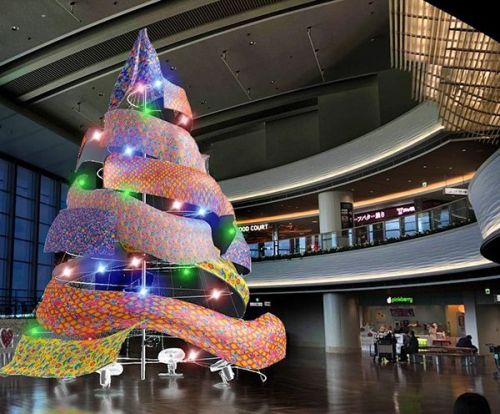
















 Webcam(Kokusai Street)
Webcam(Kokusai Street)


